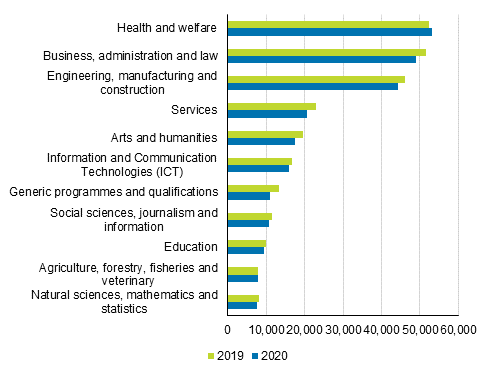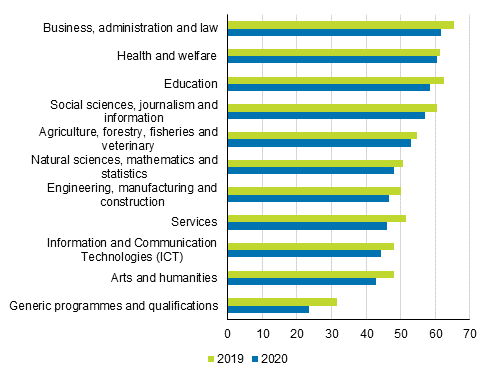Published: 16 December 2021
Number of employed persons fell most among young students in 2020
According to preliminary data of Statistics Finland's employment statistics for 2020, the number of employed students at the end of the year was 254,600, which was nearly ten per cent lower than in the year before. The number of employed students fell in all fields of education except for health and welfare, where the number of employed students grew from the previous year. The employment rate of students fell by two percentage points, being 48 per cent in 2020. Employment rate decreased among students in all fields of education.
Number of employed students by fields of education in 2019 and 2020*

* Data are preliminary
At the end of 2020, there were 254,600 employed students in Finland, which was nine per cent or 25,900 fewer employed persons than one year previously. The share of all employed persons fell, in turn, by five per cent from twelve months earlier. Examined by field of education, the number of employed students fell most in business, administration and law (-2,600), service industries (-2,300) and general comprehensive education (-2,300). By contrast, the number of employed persons among students in the field of health and welfare grew by 900 persons. 1)
The number of employed persons decreased most among young students in 2020. The number of employed students aged under 30 was 134,200, which was 13 per cent, or 20,700 lower than in the previous year. The share of all employed persons aged under 30 fell by nine per cent from the previous year. The number of employed students aged under 20 decreased by 3,900, those aged 20 to 24 by 7,100 and those aged 25 to 29 by 9,700. The number of employed students aged 30 to 39 decreased by 4,500 and those aged 40 or over by 630 from the previous year.
Nearly three out of five employed students in 2020 were women. Compared with the year before, the number of employed students decreased among both men and women by around 13,000 employed persons. Examined by field of education, most women were found among employed students in the fields of health and welfare and education (80% in both). The numbers of men were, in turn, highest in employed students in the fields of technology and information and communication technology (ICT) (both 75%).
Examined by region, the number of employed students fell in relative terms most in Satakunta (-16%), Lapland (-13%) and Uusimaa (-12%). The relative drop in the number of students compared to the previous year was smallest in Central and North Ostrobothnia (-2.8%; -3.5%) and Kanta-Häme (-3.9%).
Students' employment fell in all fields of education
The employment rate of students was 48 per cent in 2020. In the previous year, the employment rate of students was two percentage points higher, or 50 per cent. Examined by field of education, the highest number of employed persons relative to all students in the same field (aged 18 to 74) was found among students in the fields of business, administration and law (61%), health and welfare (60%), and education (58%). The number of employed persons was lowest in general education, where the share of employed persons was 24 per cent.
In 2020, the employment of students decreased in all fields of education. Employment fell most in relative terms among students in general education; it was eight percentage points lower than one year before. Employment declined second most in service industries and in humanities and arts (by five percentage points in both). Employment declined least among students in the fields of health and welfare (by one percentage point) and agriculture and forestry (by two percentage points).
Employment rate of students by field of education in 2019 and 2020, %

The number of those whose main type of activity was student grew in 2020. At the end of 2020, those whose main type of activity was student numbered 424,200, which was six per cent, or 23,300, higher than one year earlier. Those whose main type of activity is student do not belong to the groups of employed, unemployed, conscripts or those in non-military service, and fulfil the definition of student in the employment statistics 2) . Slightly over one-half, or 222,600, of those whose main type of activity is student, had also done paid work during 2020 (e.g. summer jobs), but they did not belong to employed persons during the last week of the year. The share of those who have done paid work in the course of the year and whose main type of activity was student fell by six per cent in 2020. For those with earnings, the median earnings of those whose main type of activity was student were EUR 1,800 and earnings in the highest income quartile were EUR 5,700. Eighty-five per cent of those whose main type of activity was student and had received pay were under 30 years of age.
1) The number of employed students includes employed persons aged 18 to 74 who are registered at educational institutions during the autumn term, receive student financial aid in the autumn or attend labour force training at the end of the year. The examinations of fields of education include those registered at the educational institution during the autumn term.
2) In the employment statistics, those whose main type of activity is student include persons aged 15 to 74 who are registered at educational institutions during the autumn term, have received student financial aid in the autumn, attend labour market training at the end of the year or are in the 9th or 10th grade or aged 15.
Source: Employment Statistics, Statistics Finland
Inquiries: Meri Raijas 029 551 3061, Mikko Toiviainen 029 551 3589, info@stat.fi
Head of Department in charge: Hannele Orjala
Publication in pdf-format (235.3 kB)
- Releases
- Reviews
-
- 1. Economic dependency ratio was 142 in 2020 (10.3.2022)
- Tables
-
Tables in databases
Pick the data you need into tables, view the data as graphs, or download the data for your use.
Appendix tables
Updated 16.12.2021
Official Statistics of Finland (OSF):
Employment [e-publication].
ISSN=2323-6825. profession and socio economic position 2020. Helsinki: Statistics Finland [referred: 19.12.2025].
Access method: http://stat.fi/til/tyokay/2020/01/tyokay_2020_01_2021-12-16_tie_001_en.html

